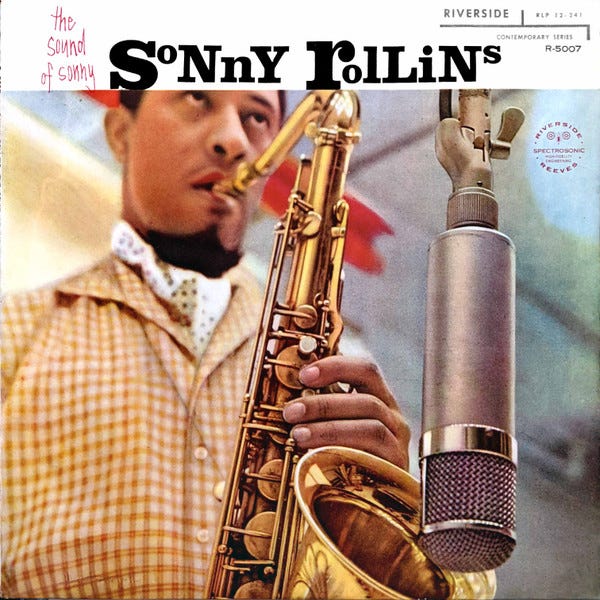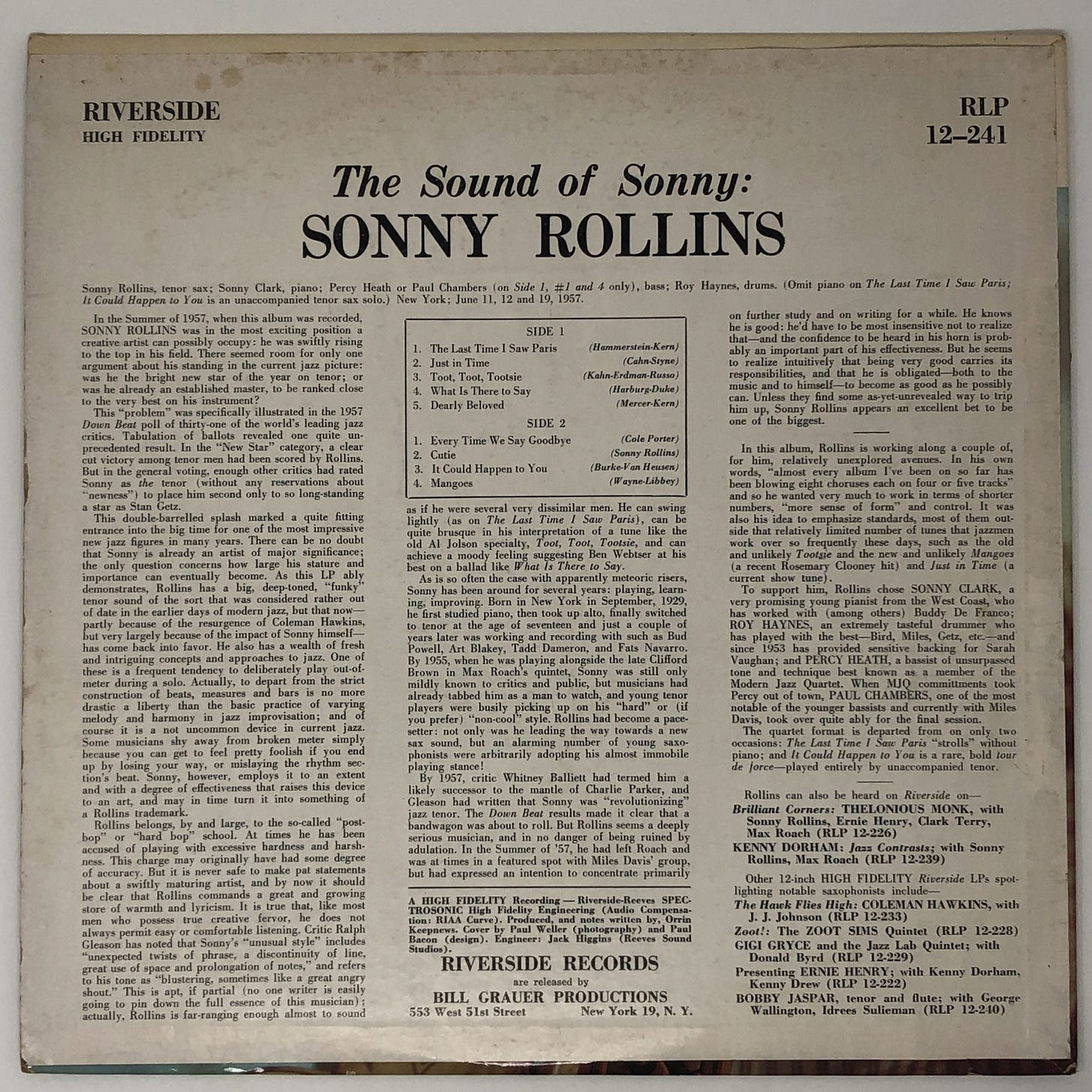Sonny Rollins and Sonny Clark: Unissued Outtakes, 1 (+Bonus from Freedom Suite)
The first Sonny Rollins recording I ever heard was the single track “Just Friends” with Coleman Hawkins and Paul Bley from 1963, and, as I’ve told you, I loved his playing on it immediately. Soon after, the first full album I bought by Rollins was Sonny’s Time, on Riverside’s budget line, Jazzland—because it happened to be on sale for one dollar. Later, I learned that five of the seven tracks on that album came from The Sound of Sonny on Riverside Records. That 1957 album is a delight, and it’s the only meeting of the two Sonnys, Rollins and Clark. (To avoid confusion, I’ll refer to our saxophonist as “Sonny” or “Rollins,” but I’ll always call the pianist “Clark.”)
As with most Riverside releases, Orrin Keepnews produced the session and wrote the liner notes, which you can read below:
Rollins’s playing is consistently terrific from when he returned from his first “sabbatical” in November 1955 until he took another break in the fall of 1959. I absolutely do not “get” why Saxophone Colossus is always singled out as being better than his other albums from those years. It’s excellent, of course—but so are the others. Maybe it’s simply because of the word “Colossus” in the title—maybe advertising does work!
But The Sound of Sonny is a beautiful album, and what a rhythm section! In addition to Clark there’s Percy Heath (bass), and Roy Haynes (drums). This was recorded in New York City in June 1957, and there was another session with Paul Chambers replacing Heath, on June 19, 1957. Some outtakes from the session with Heath have circulated among a small circle of collectors, and today I will begin to share them with you.
Jack Higgins was the regular engineer for Riverside, and Reeves Sound Studios at 304 East 44th Street was the usual location:
The studio was founded in 1933 by Hazard Reeves, an audio pioneer. He was especially well known for his innovations in film soundtracks, and Higgins recorded many of those as well.
The dates are usually given as June 11 and 12, suggesting two separate days, but in fact this was recorded in one long night, starting on June 11 and ending in the early morning of June 12. I know that because Keepnews explicitly said that the studio was always booked during the daytime and that he could only use it after hours, at night, and also got a good rate that way, which saved money. Today we will hear the development of “Just In Time” in the studio, in Sonny’s arrangement, after midnight (that is, early morning) on June 12, 1957. (We owe thanks to James Accardi, who is knowledgeable about jazz and about old audio, for removing some hiss and making improvements to the speed and pitch of these files.) As you’ll hear, Higgins, the engineer, has a distinctive style: He will announce a reference number, then “selection one” (or two, as the case may be), instead of the title, then the take number, and then instead of saying “Go” or “Rolling,” he says “Speak.” So, in this case, he says"565, selection one, take one—Speak.” (Maybe “speak” was used when he was recording for films?) It’s a fine performance, and at the end Sonny says “Let’s hear it back.” Here is Take 1:
For whatever reason, they decide to do a second take. Higgins’s full announcement is missing on my copy—we just hear “Speak.” Sonny ends his solo with an impressive flurry of notes at 1:45. This time the take breaks down during the trading with Haynes, just before the final theme would have been played. Here is Take 2:
So it’s on to Take 3. Clark takes a particularly nice chorus here. It’s a complete take with no problems. Here is Take 3:
But again Sonny wants to do another one. It was common for Rollins to feel unsatisfied and to record many takes. So they record Take 4. This time Roy does a very complicated drum pattern during the last trade, and he forgets the rhythm for the closing theme. This leads to some good-natured laughter, and an incomplete take. Here is Take 4:
They could have spliced onto Take 4 the closing theme of another take, but instead, Take 5 is announced by Higgins. It appears that maybe somebody’s not ready, because at first Sonny says “Go ahead, man” but then he says “Just hold everything”:
After that, they created the take that is on the finished album. You’ll notice a major improvement in the audio quality because below is how it was issued, after mixing and so on. So here is the “Master Take,” which I believe was Take 5 (unless there is a take missing on my tape):
I’m personally not certain that the issued version is the “best.” There are great moments in every take. That’s one reason it is valuable to study the development of a piece chronologically through a recording session. Besides, it also means more music to enjoy from these marvelous musicians. I hope you agree. I’ll be back to follow another track from this album, from first take to released performance.
All the best,
Lewis
Keep reading with a 7-day free trial
Subscribe to Playback with Lewis Porter! to keep reading this post and get 7 days of free access to the full post archives.





